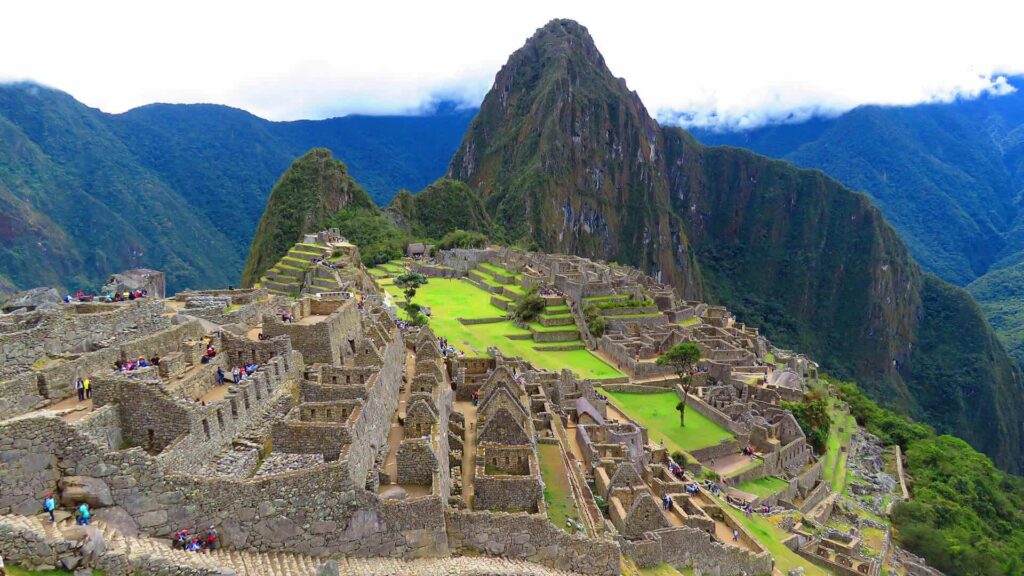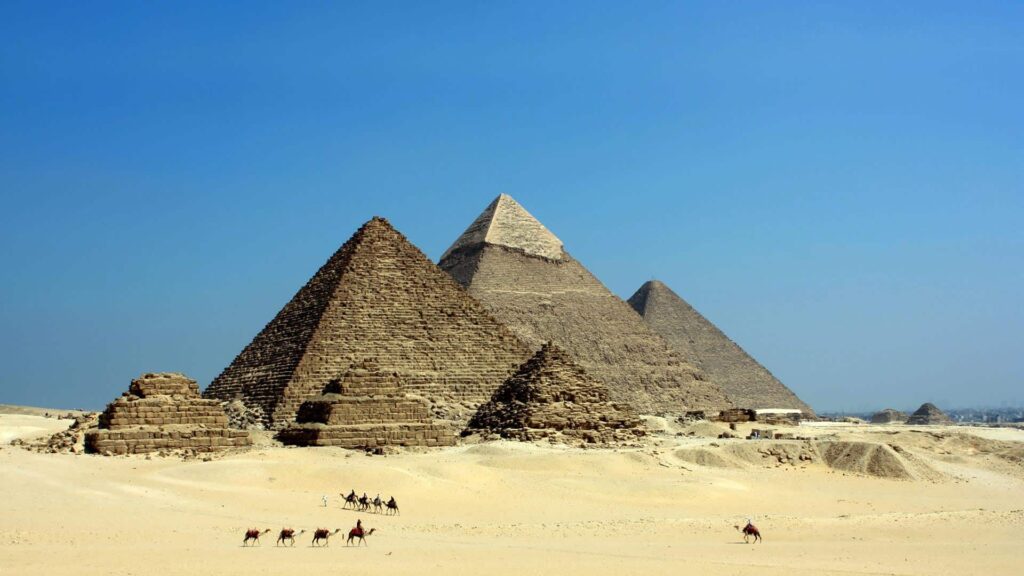The rich past of India, encompassing cultural, religious, and the origins of religions like Hinduism, Jainism, Buddhism, and Sikhism, is well known. India is a country where people of all religions live in harmony and peace.
The Hindus refer to the Lord’s celestial home on earth as the ‘Mandir’. There are gorgeous temples around the country.
Each temple has a unique history and legend. In the past, Indian emperors would commission artists and sculptors to create gigantic marvels in the form of temples within their territories. These temples tell stories and legends of the past, guarding it for the future.
This article will introduce you to some wonderful and breathtaking temples in India.
Shore Temple
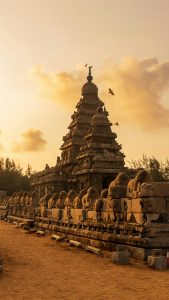
Of all the temples and monuments in the area, the Mamallapuram Shore Temple is undoubtedly the most stunning.
Scholars believe that the old Pallava emperor Rajasimha/Narasimhavarman II built the structure during his reign, and it is one of South India’s earliest popular temples.
The coastal temple remained buried in sand until very recently. The temple has two sanctums: one for Lord Shiva and the other for Lord Vishnu.
Experts consider the temple, which is made of cut stones and granite slabs, a masterpiece of pure Dravidian architecture. A pyramidal Kutina tower consists of stepped floors topped with a cupola and a finial.
Khajuraho Temple

The Khajuraho Group of Monuments is a collection of Hindu and Jain temples in Chhatarpur district, Madhya Pradesh, India, approximately 175 kilometers (109 miles) southeast of Jhansi.
The temples are famous for their Nagara-style architectural symbolism and lively sculptures.
The Chandela dynasty constructed, between 950 and 1050, most of the temples in Khajuraho.
The Khajuraho temple complex included 85 temples in the 12th century and covered an area of 20 square kilometers. Only 25 have survived now.
Among the remaining examples, the sculptural embellishments on the Kandariya Mahadeva Temple provide the most extensive demonstration of the meticulous workmanship, symbolism, and expressiveness that distinguishes ancient Indian art.
Meenakshi Amman Temple

The Meenakshi Sundareswarar Twin Temple is one of the largest and most prominent in India. Potential donations and successful monarchs of each dynasty grew the temple into a massive building spanning 65000 square meters. The temple has a history of being built 2000 years ago and underwent substantial renovations during the reign of Thirumalai Nayak (1623-55 AD).
People dedicate the Meenakshi Sundareswarar twin temple to Lord Shiva in his incarnation, Sundareswarar, and his fish-eyed consort, Meenakshi.
Ramanathaswamy Temple
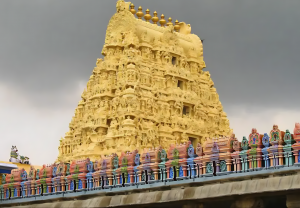
The Holy Abode of the Hindu God, Shri Ram, is a virtual heaven for believers. No Hindu voyage is complete without a pilgrimage to Varanasi and Rameswaram as the endpoint of his quest for salvation, as depicted in the epic ‘Ramayana’. Folklore tells of God Ram’s arrival in this country after a 14-year exile.
According to local legend, after Shri Ram defeated the demon Ravana, his brother Lakshman and Hanuman, along with his army of thousands of monkeys, helped him to return to Rameswaram and India.
Sri Ranganathaswamy Temple
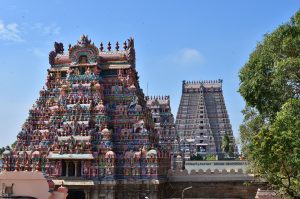
Sri Ranganathaswamy Temple is a magnificent Vaishnavite temple dedicated to Lord Vishnu that covers an area of 156 acres. People also regard it as the earliest, largest, and most important of the 108 main Vishnu temples.
There are 21 impressive, massive towers. This temple is located on an island created by the twin rivers Kaveri and Kollidam. This temple underwent numerous changes under the reigns of the Cholas, Cheras, Pandiyas, Hoysalas, Vijayanagar emperors, and the Nayak of Madurai.
Jambukeswarar Temple

According to belief, Lord Shiva manifested as the element of water (Neer) in the Jambukeswarar temple in Thiruvanaikovil. The reigning gods are Lord Jambukeshwarar (Lord Shiva) and His consort Goddess Akilandeswari (Goddess Parvati).
Because the Lingam in this temple is mostly immersed in water, people refer to it as the “Appu Lingam” or Lingam of Water. This temple is also known as ‘Appu Sthalam.’ Lord Shiva’s Lingam is “Swayambhu,” which translates to “self-manifested.”
Brihadeeswarar Temple
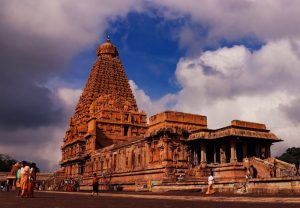
The Brihadeeswara Temple, commonly referred to as the Peruvudaiyar Kovil is located in Thanjavur. This magnificent temple is devoted to Lord Shiva, who is portrayed as the enormous ‘Lingam’. The temple was built in 1010 AD by Chola emperor Rajaraja Chola I. With the Gangaikondacholeeswaram Temple and the Airavastesvara Temple, this temple is one of the three ‘Great Living Chola Temples’.
The temple is well-known for its large sculpture of Nandi, Lord Shiva’s sacred bull. The sculpture is formed of a single rock and stands 13 feet tall and 16 feet long.
The whole construction of this temple is built of granite, and the spectacular ‘Gopurams’ include elaborate sculptures.
Somnath Temple
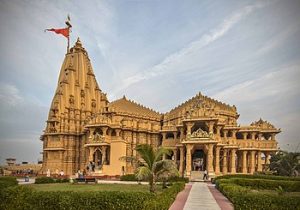
Somnath temple, located on Gujarat’s western coast, is believed to be the first of Shiva’s twelve jyotirlinga shrines.
After being destroyed multiple times by Muslim invaders and the Portuguese, the current temple was rebuilt in the Chalukya style of Hindu temple architecture and finished in May 1951. Vallabhbhai Patel finished the reconstruction.
Somnath has been a pilgrimage site since ancient times due to its location at the confluence of three rivers: Kapila, Hiran, and Sarasvati.
Padmanabhaswamy Temple
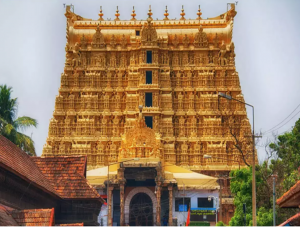
The Sree PadmanabhaSwamy Temple, the residing god of Lord Vishnu, is located inside the East Fort in Thiruvananthapuram. This temple blends the architectural traditions cherished by the state of Kerala and the Dravidian architectural traditions. It is supposedly the richest temple in the world.
This temple dates back to the eighth century. This shrine is one of the 108 holy temples of Lord Vishnu; it is also called Divya Desam. The main idol of this temple is Lord Vishnu himself, lying in a position with Anantha Shayanam, the hooded serpent.
Golden Temple
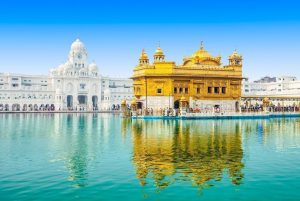
The Golden Temple, also known as Sri Harmandir Sahib, is located in Amritsar, the Sikh holy city.
The Mandir is a two-story structure built on a marble square of 67 feet. Maharaja Ranjit Singh created the upper portion of the building using around 400 kg of gold leaf.
In 1604, Guru Arjan, the fifth Sikh Guru, deposited a copy of the Adi Granth in the Golden Temple, emphasizing its importance in its creation.
From 1883 to the 1920s, it served as a hub for both the Singh Sabha Movement and the Punjabi Suba Movement, which lasted from 1947 to 1966.
Conclusion
From the Shore Temple at Mahabalipuram to the Golden Temple in Amritsar, India’s temples speak to distinct aspects of the country.
Coming to these breathtaking temples safeguards the value of their beauty and significance for the future.
What mysteries and secrets might the old temple walls in India hold? How could old-world artists and craftsmen create such immortal masterpieces?

